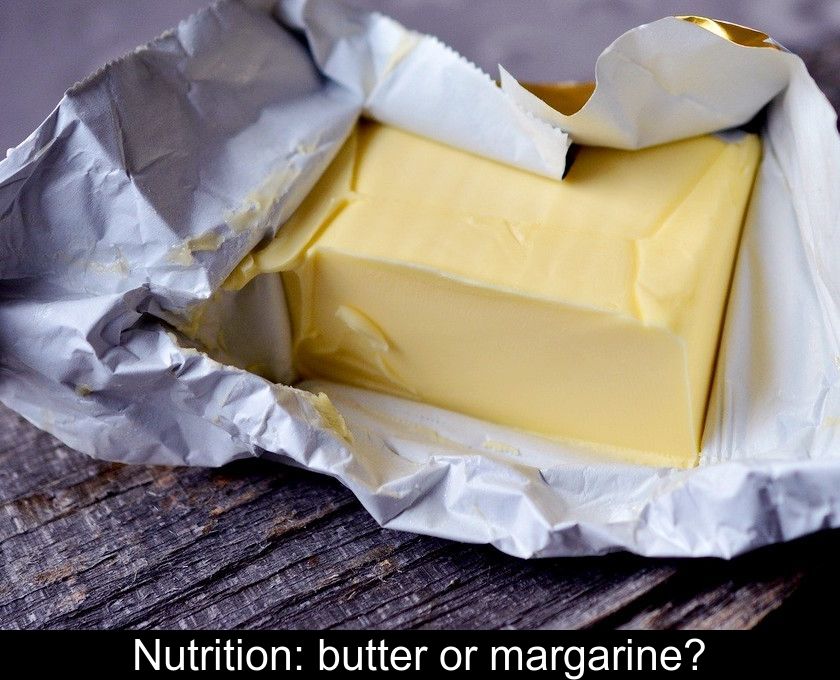Nutrition: Butter Or Margarine?
Butter and margarine are usually contrasted in terms of health benefits. But if you take a closer look at these two fats, the difference for health is not so obvious. So, should you choose butter or margarine on a daily basis? Here are some answers.
For the calories, it's the same
In terms of calories and fat content, eating butter or margarine is about the same.
This is because butter, which is made from the cream of milk, is mostly fat. It contains 82% fat and provides 753 calories per 100 g.
Margarine, which is made from a mixture of vegetable oils such as rapeseed, Sunflower or olive oil bound with an emulsifier, provides 80% fat and 726 calories per 100 g.
Whatever you choose, you should consume these fats in moderation. You should not exceed 30 grams per day.
For vitamin A, eat a little butter
Even if butter is a very fatty food to be limited, it should not be completely eliminated from your diet because it provides essential fatty acids and vitamin A.
With 700 micrograms of vitamin A per 100 g, a 20 g serving of butter covers a quarter of the daily requirement of this vitamin.
Now, vitamin A is essential for vision and good immunity. This vitamin also contributes to the beauty of the skin and to growth in children.
For its part, margarine is a source of antioxidant vitamin E, especially when it is made with Sunflower oil. A 20 g serving then covers 20% of the daily requirement of vitamin E.
For cholesterol, the answer is controversial
In the butter vs. margarine match, butter is often criticized for being rich in saturated fatty acids that can increase the level of bad cholesterol or LDL.
Indeed, butter contains 55.4% saturated fatty acids.
Too much consumption can therefore lead to an excess of bad cholesterol and promote atheromatous plaques that are deposited on the walls of the arteries.
However, some studies qualify this statement: they show that, even if your bad cholesterol level is high, you can consume butter without increasing your risk of cardiovascular disease provided you limit its quantity to about 15 g per day.
For their part, margarines are composed mostly of vegetable fats such as sunflower, rapeseed or palm. They provide omega 6 and 3 which participate in a good cardiovascular health.
But be careful, you have to check their composition carefully because each brand has its recipe. However, their health benefits depend on their composition.
The most important thing is that the ratio between omega 6 and omega 3 is balanced. Specifically, you need at most 5 omega 6 for 1 omega 3. If this balance is not respected, the benefits of margarine on cardiovascular health are lessened.
In addition, some margarines are enriched with phytosterols, plant lipids that regulate blood cholesterol levels. However, phytosterols have not been proven to reduce cardiovascular risk. In large amounts, they may even decrease the absorption of vitamins A, D, E, and K.
That is why it is best to avoid margarines containing phytosterols and favor those made with rapeseed, flax, and walnut oil.
For cooking, prefer margarine
At high temperatures, butter turns brown due to the Maillard reaction: this phenomenon makes it more indigestible and produces toxic carcinogenic compounds.
That's why, for high temperature cooking, it's best to use margarines yet the mention cooking or simply olive or peanut oil.
Special cooking margarines contain a specific blend of oils that do not denature with heat and do not lead to the formation of toxic carcinogenic compounds.
On the other hand, for light cooking, at a temperature lower than 130°C, it is possible to use both butter and margarine.
In conclusion
As often when it comes to nutritional balance, it is necessary to avoid excess, both for butter and margarine because they are very fatty products and therefore very caloric.
On a daily basis, you can vary the pleasures to take advantage of the vitamin A contributions of butter and vitamin E of margarine as well as the omega 3 of certain margarines.
Remember that it is better to consume butter raw and use margarine for cooking, especially for high temperature cooking.








